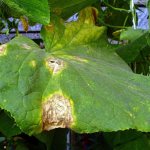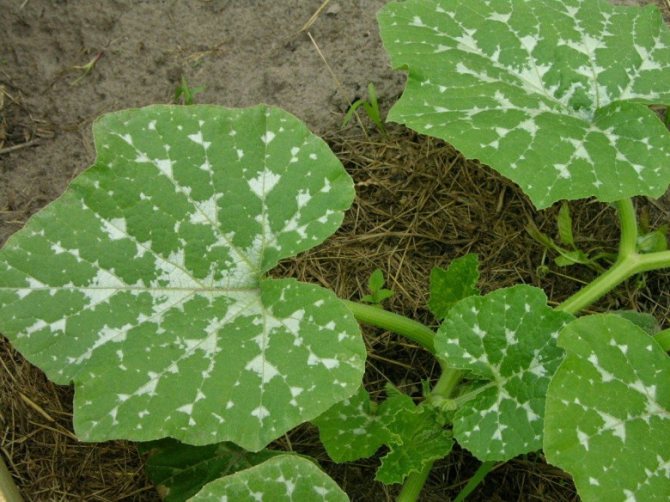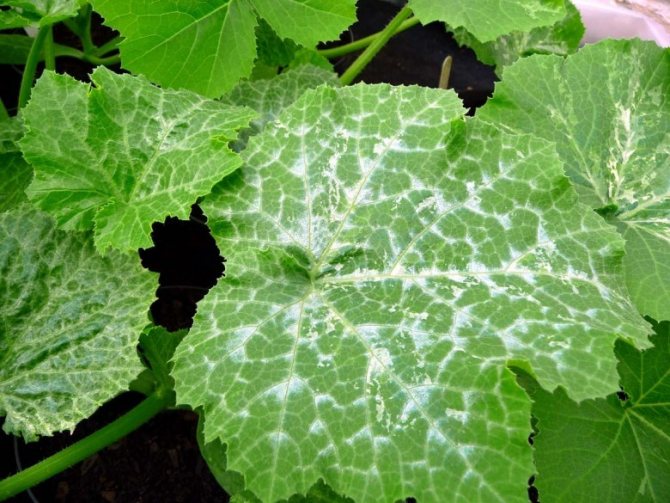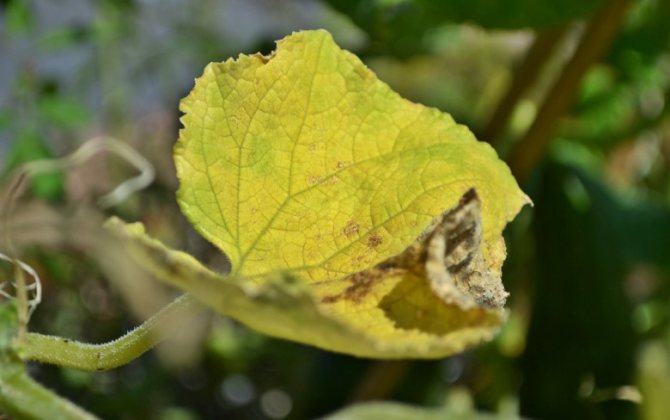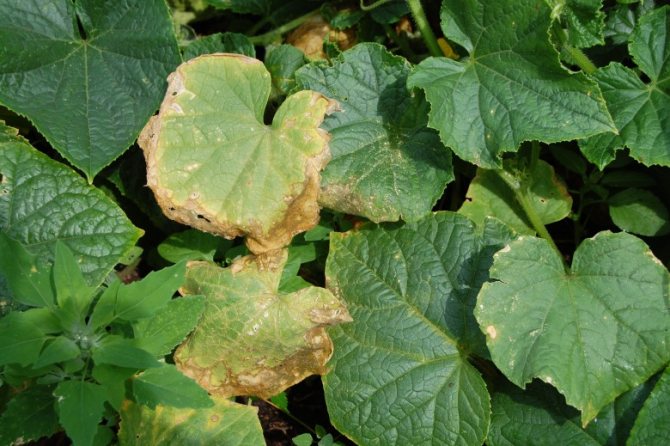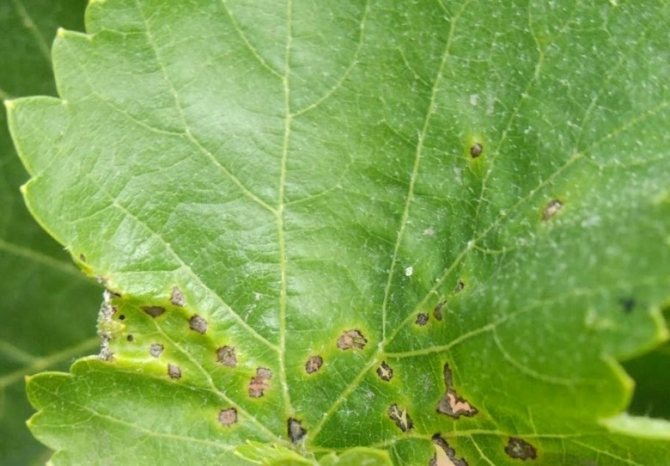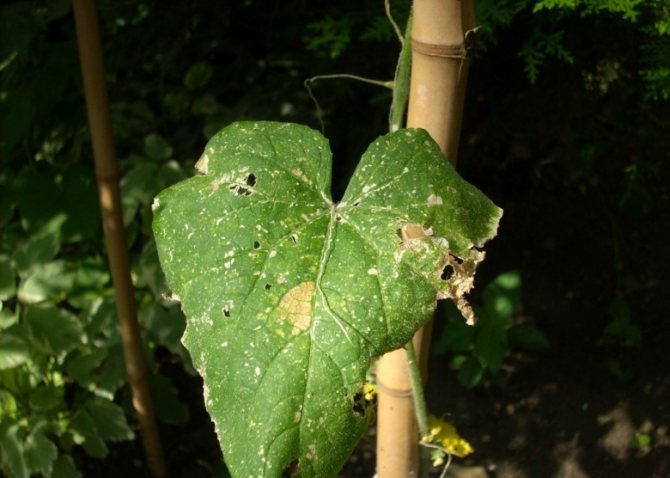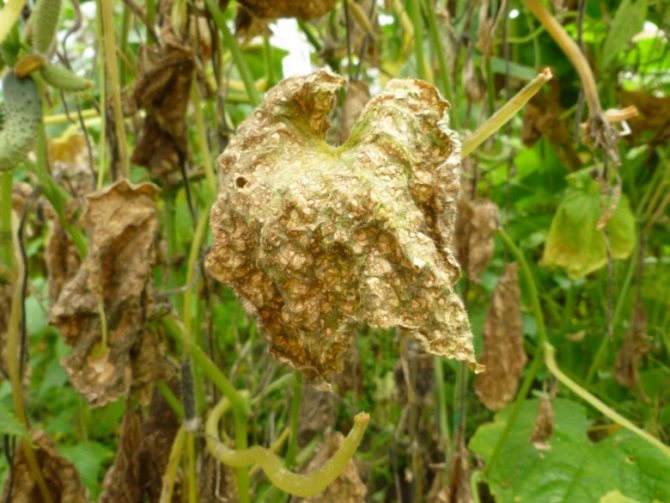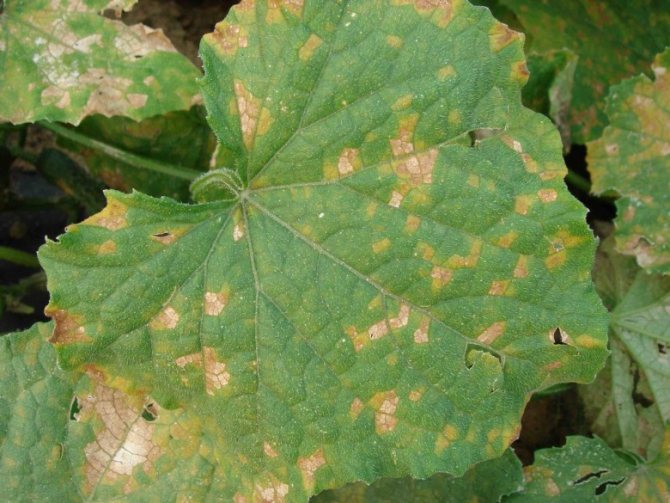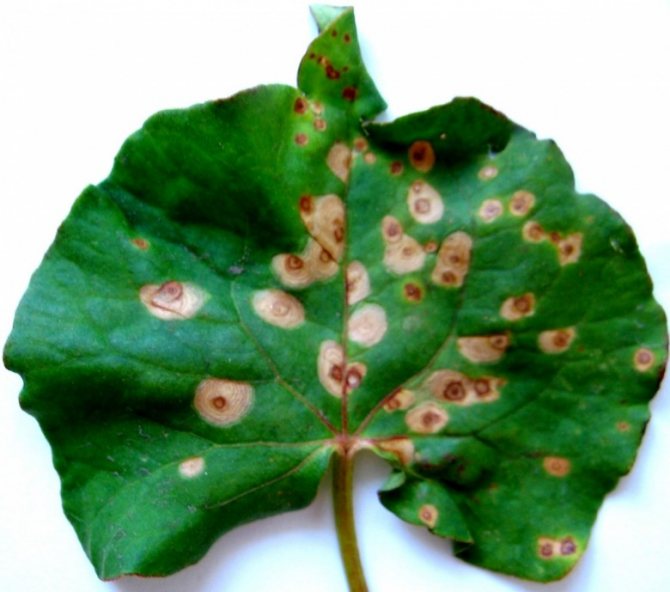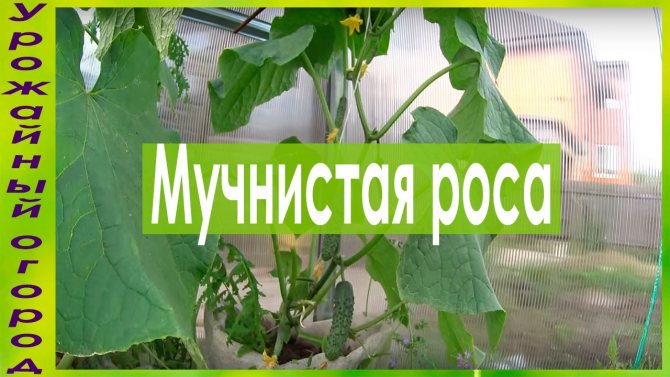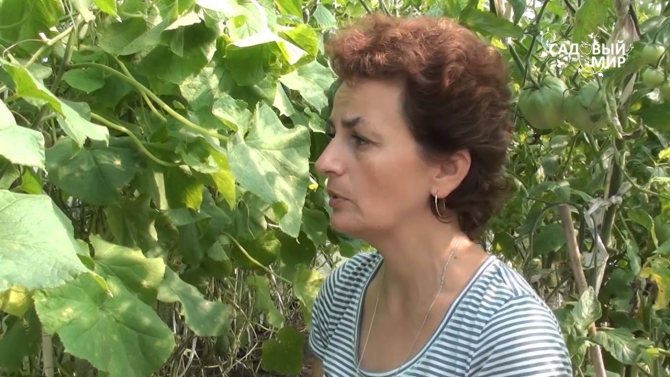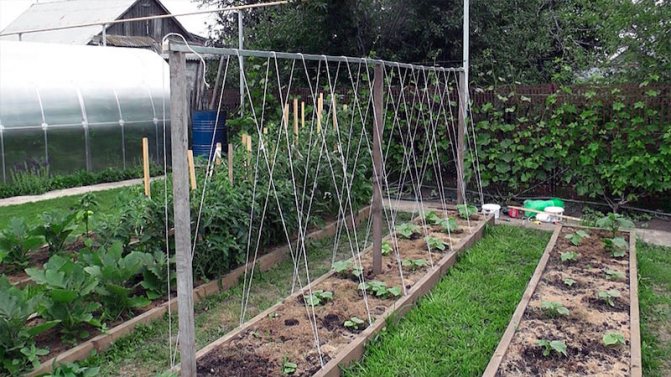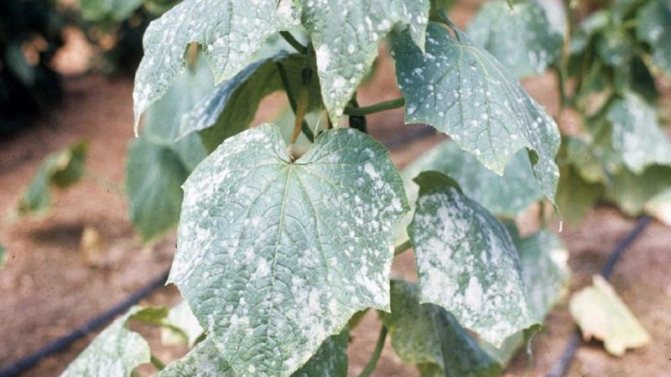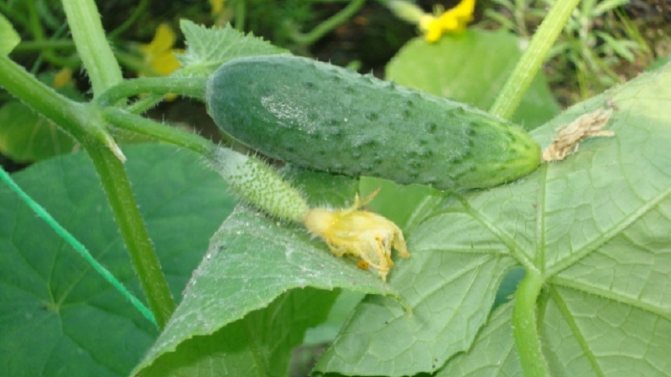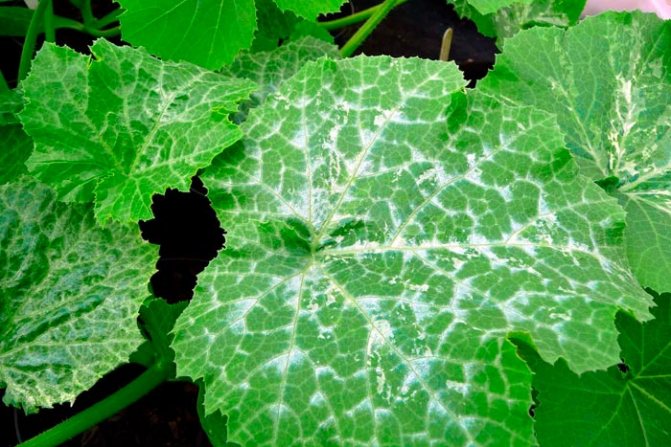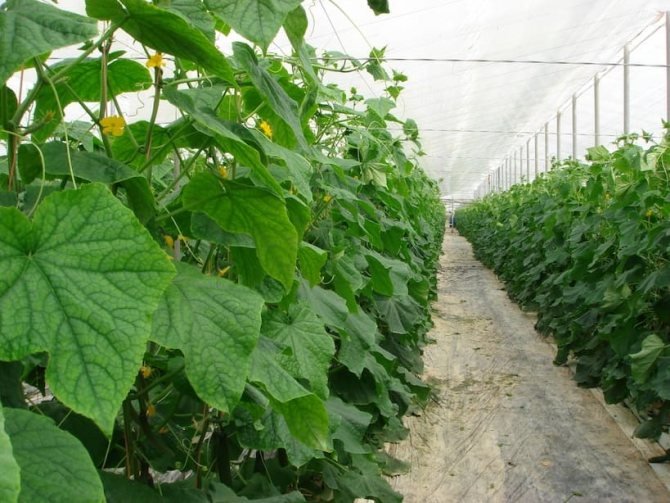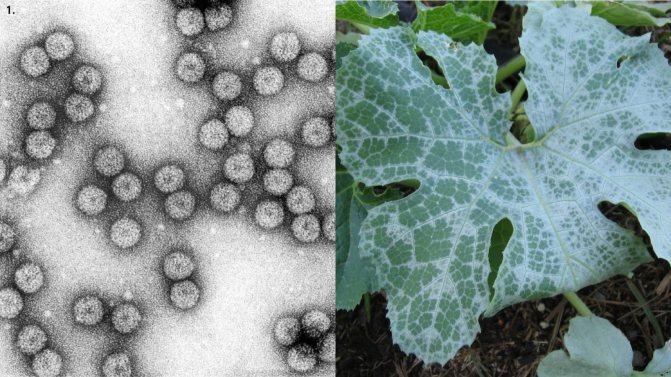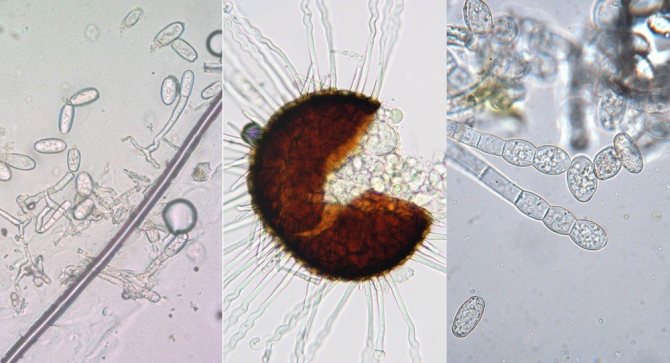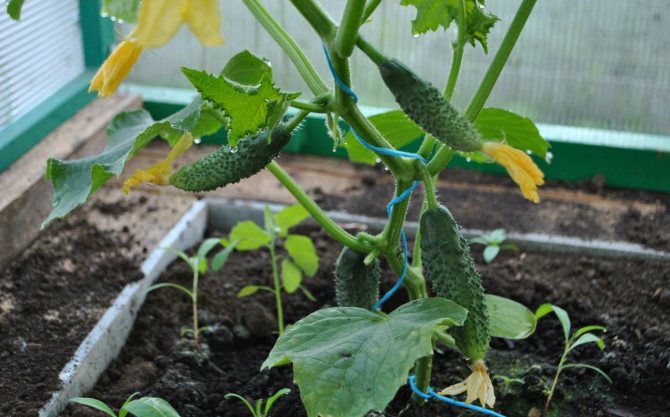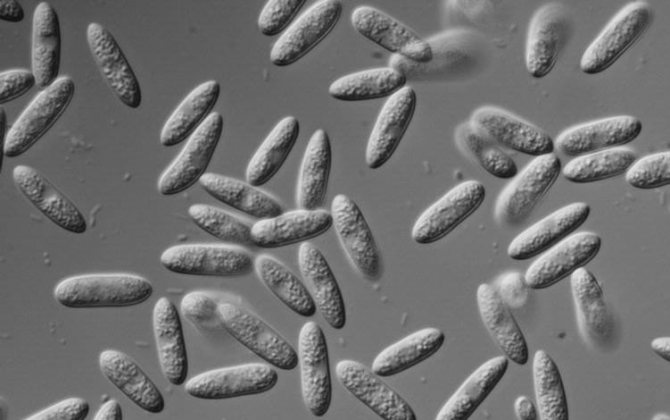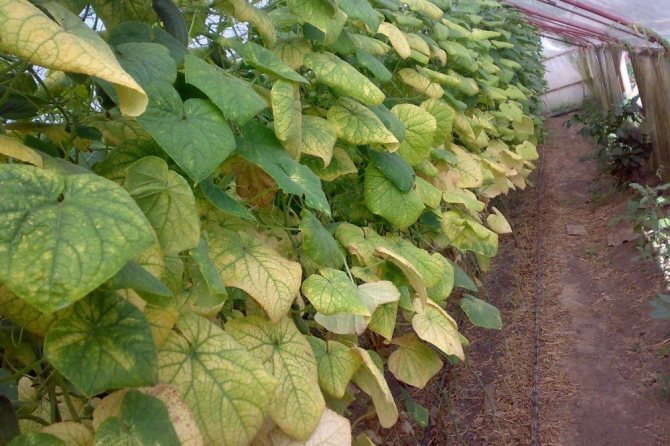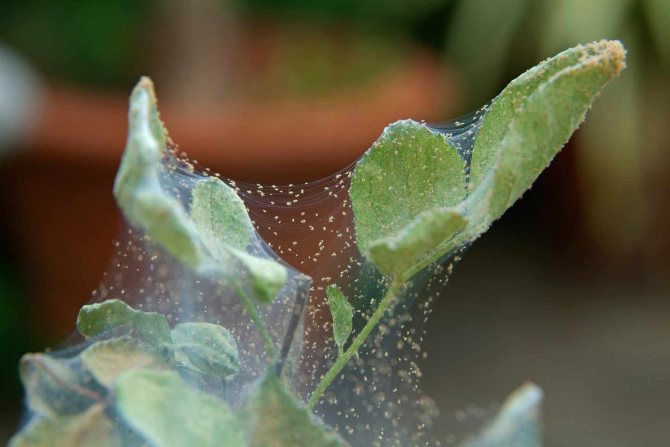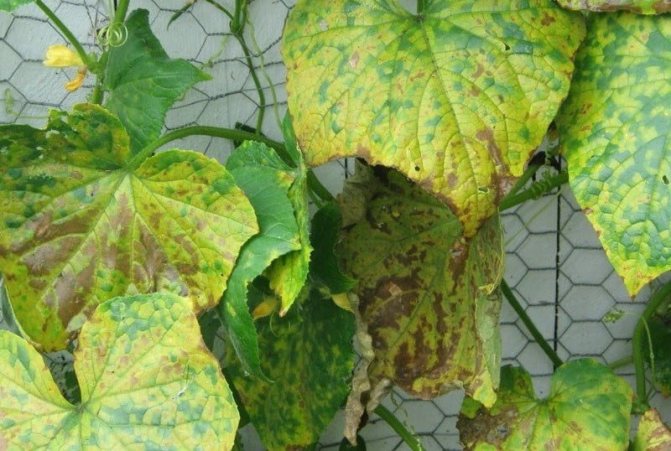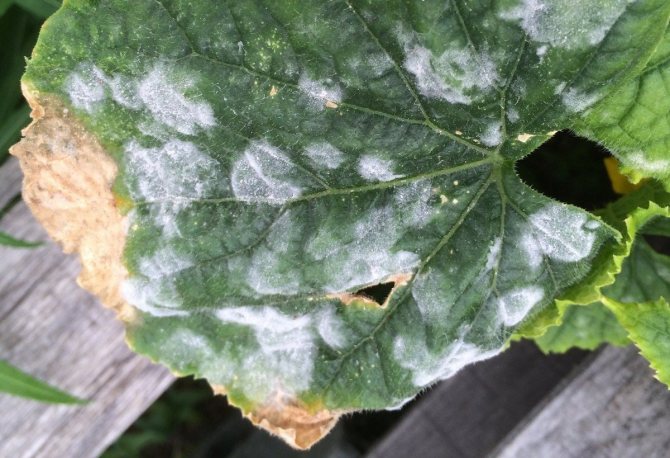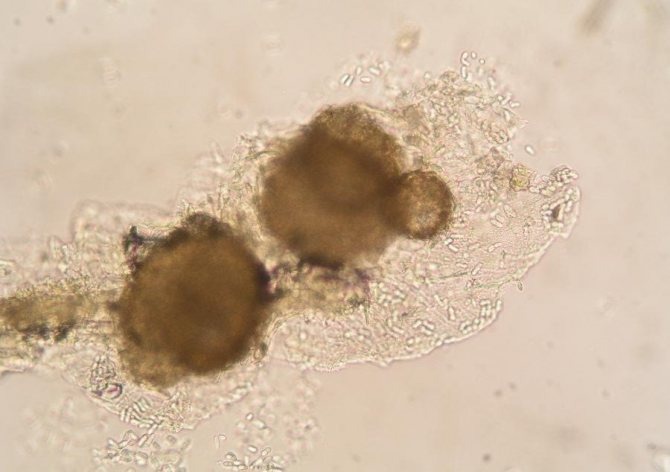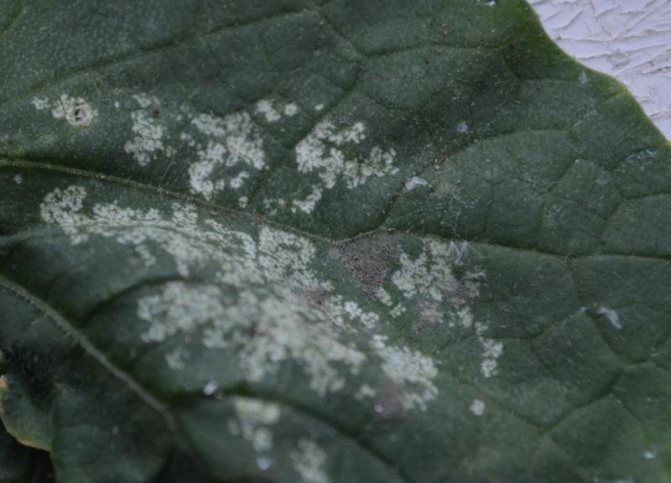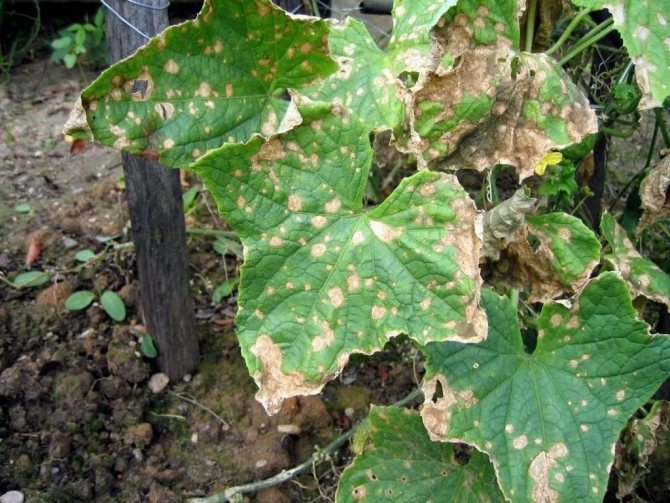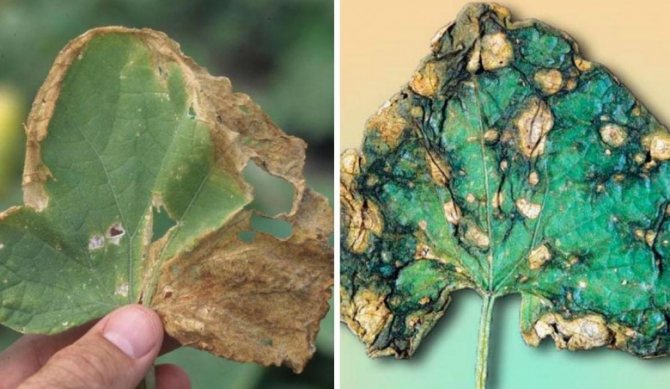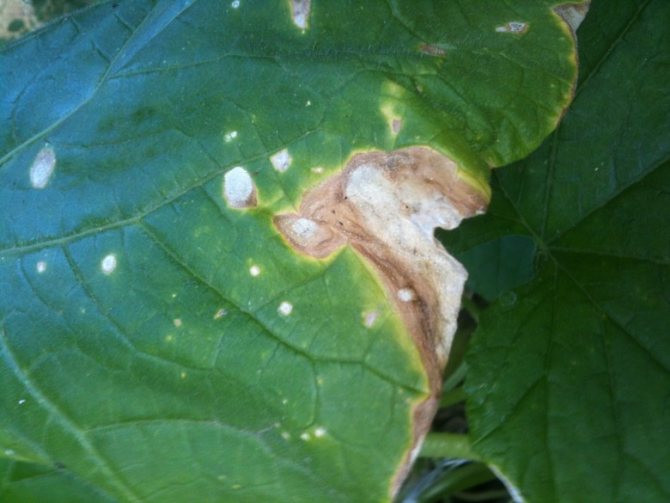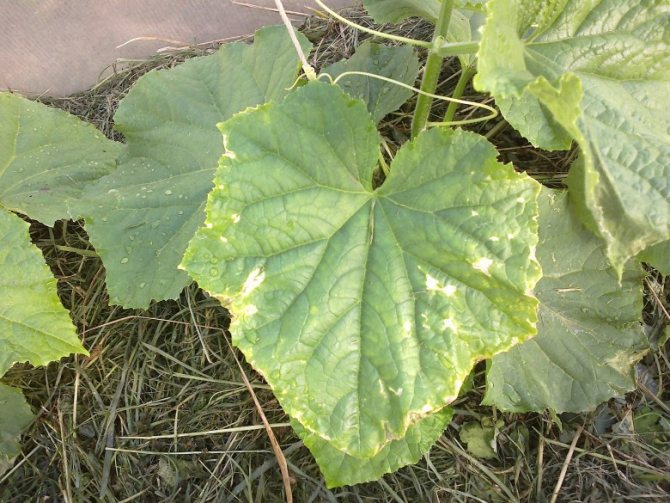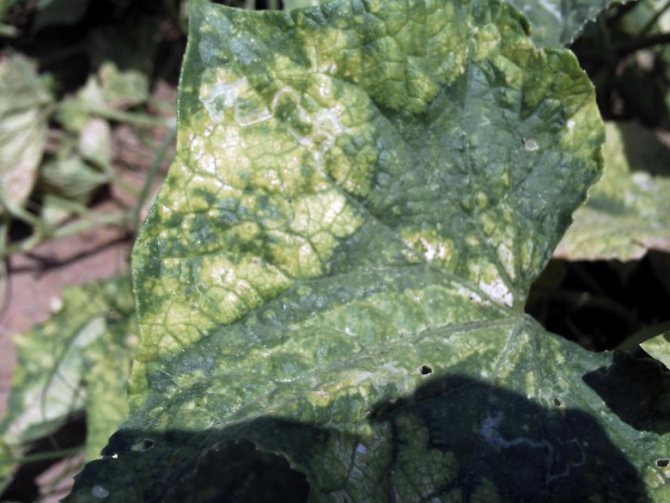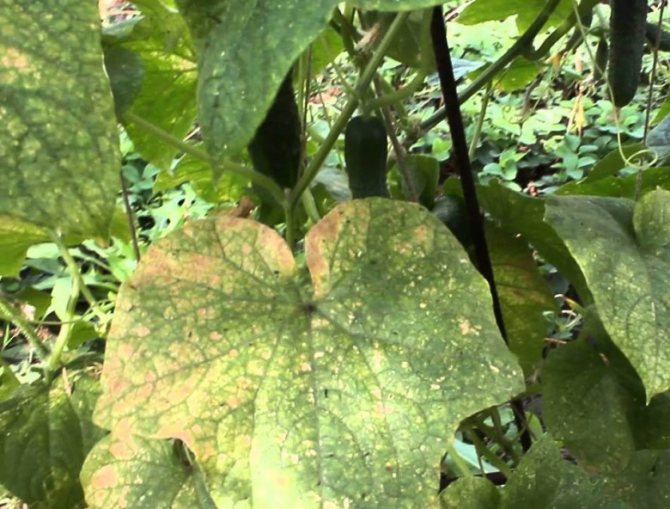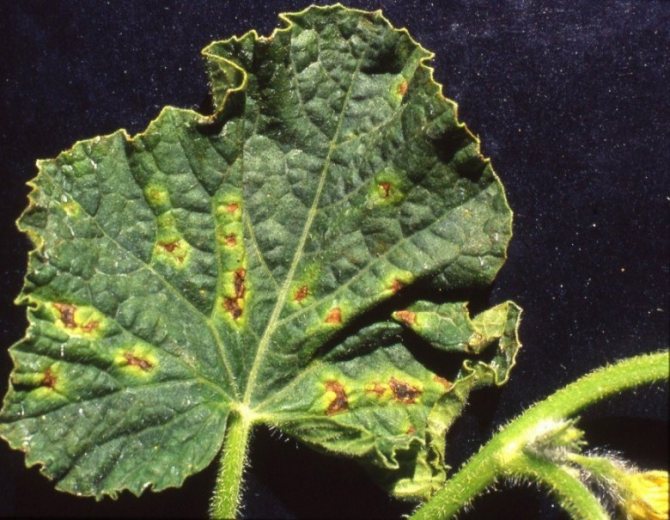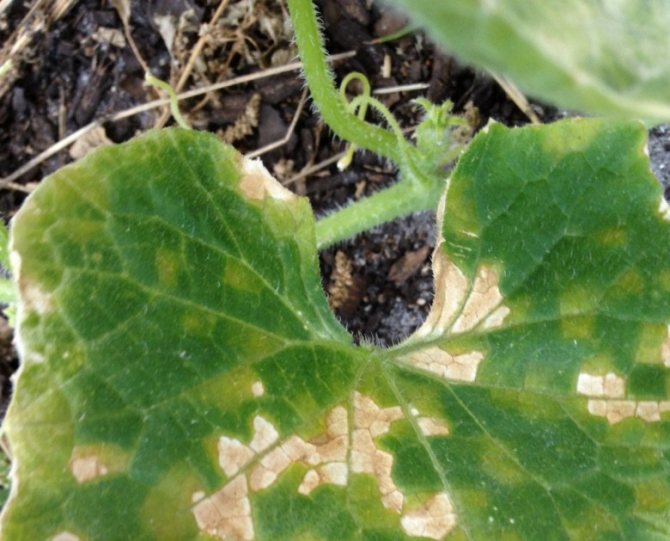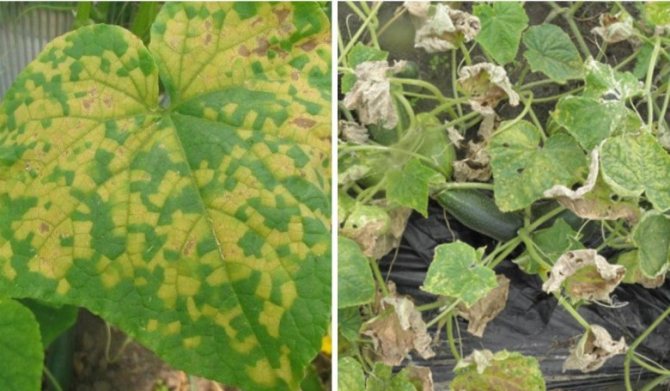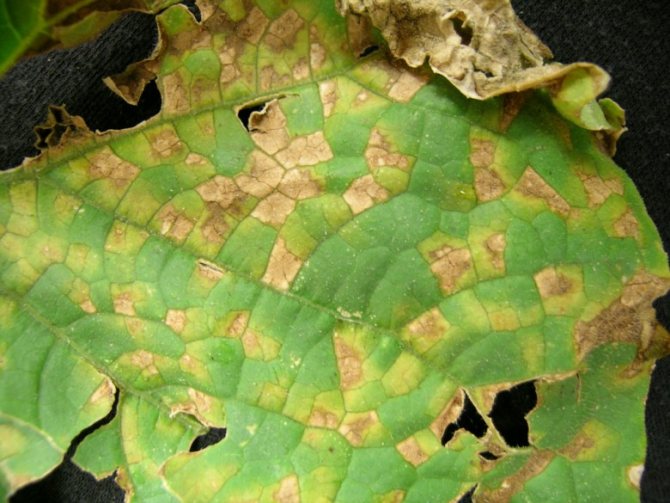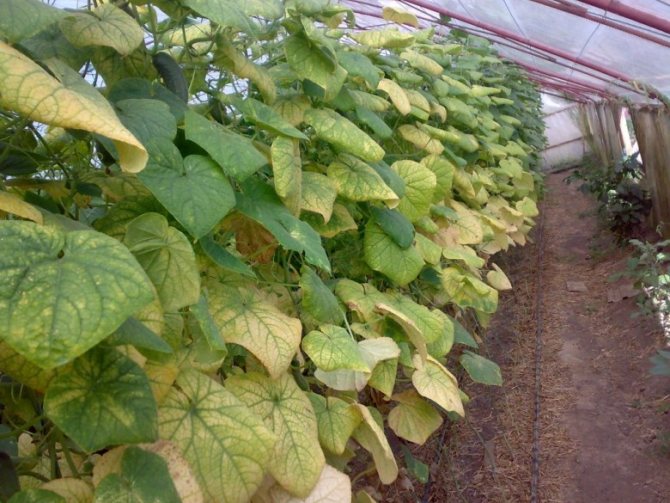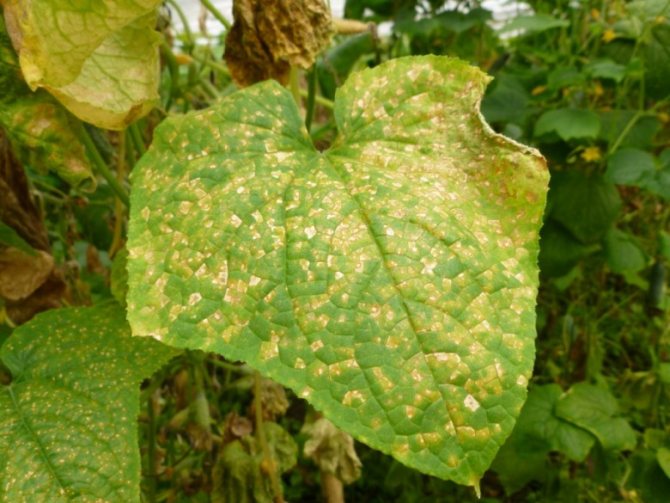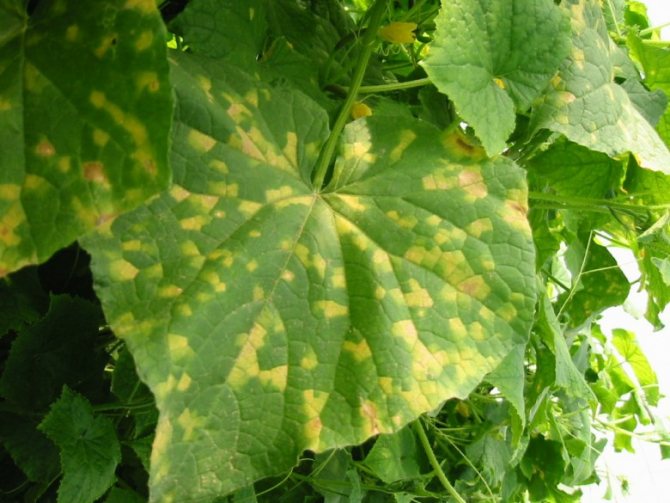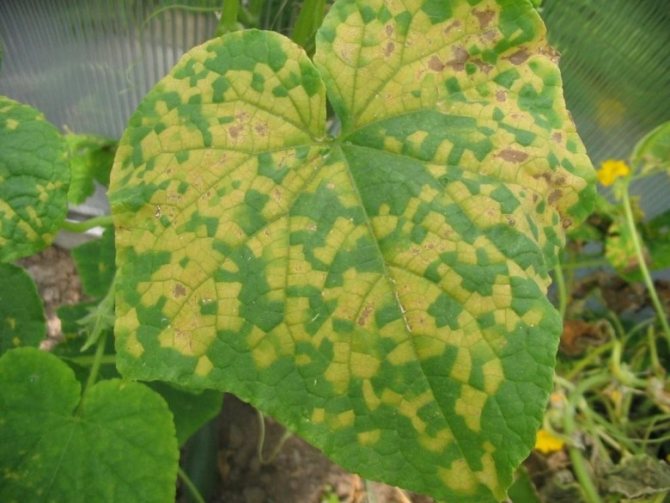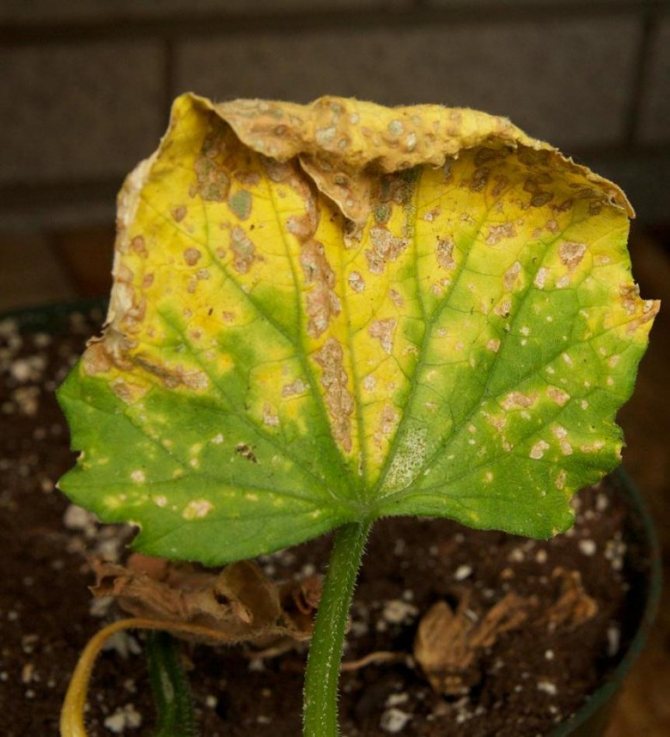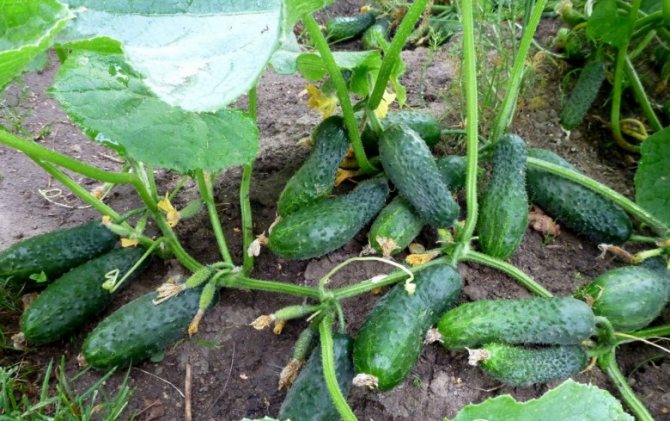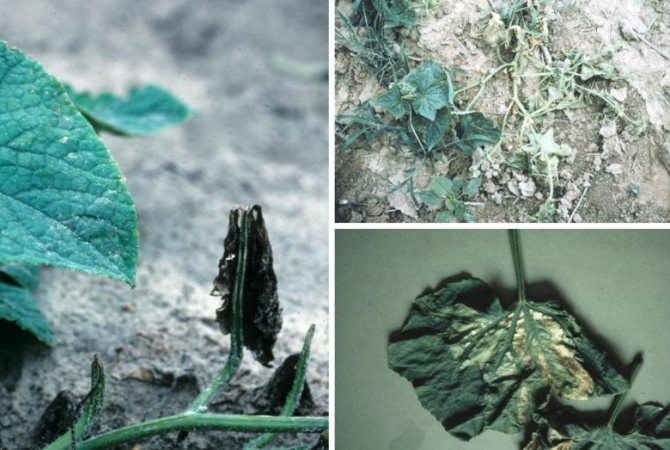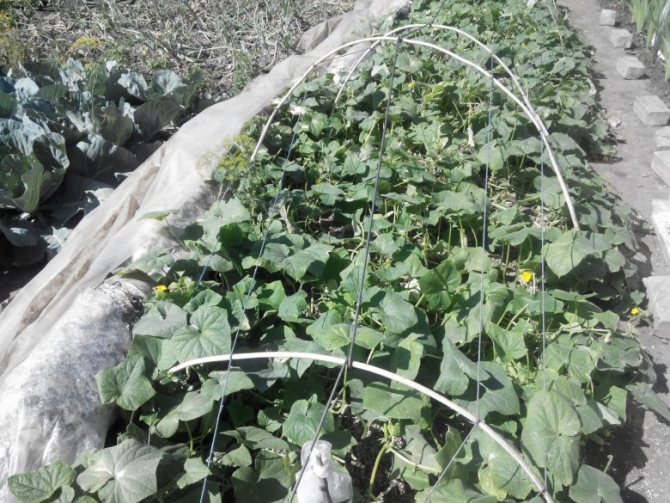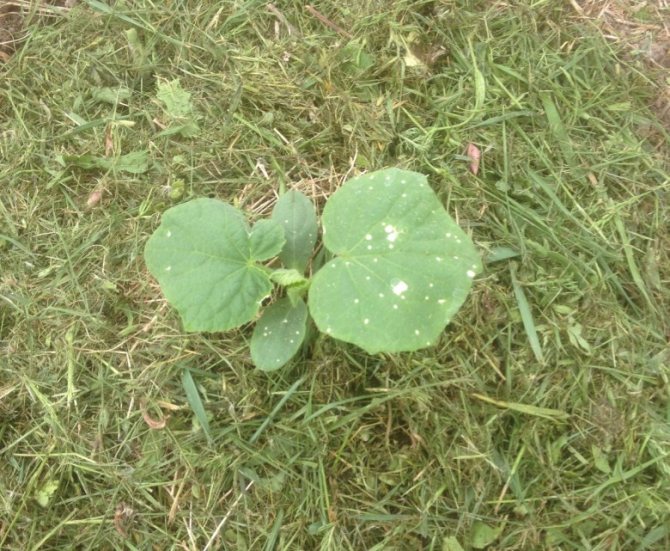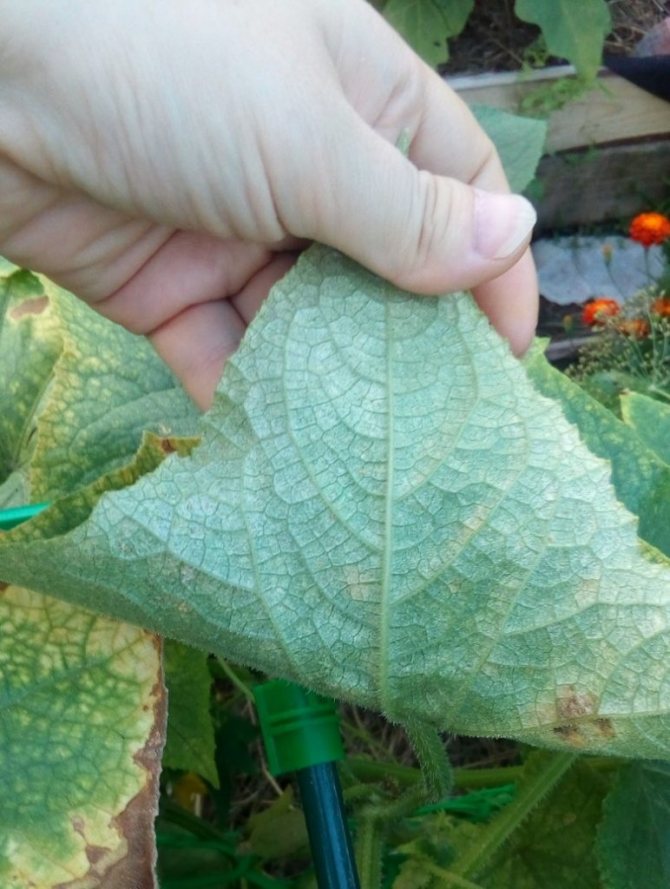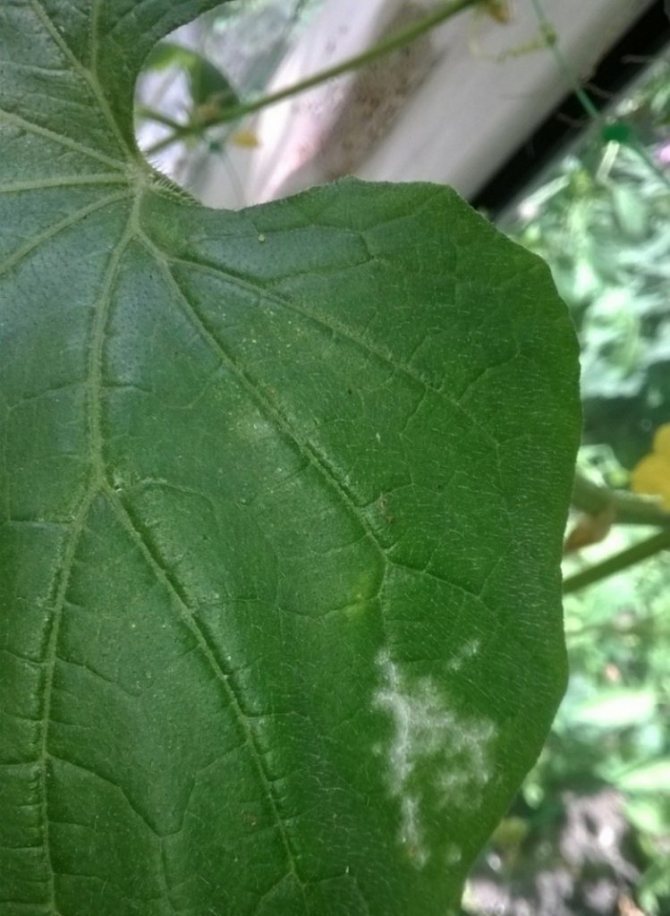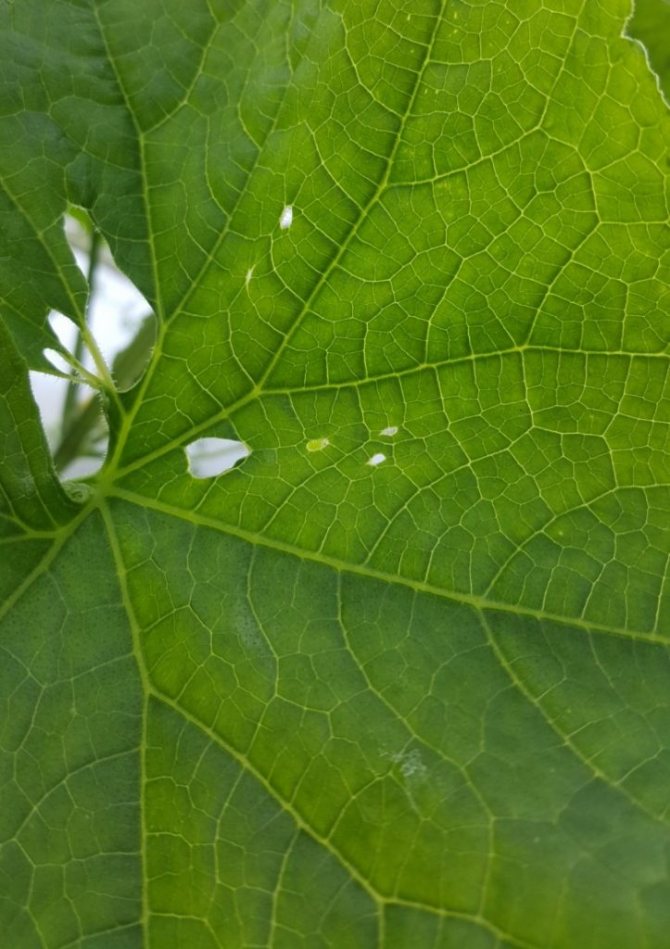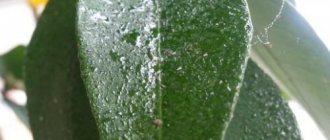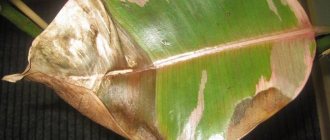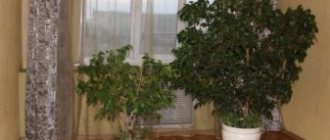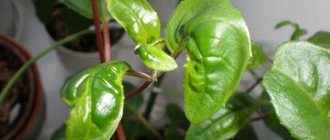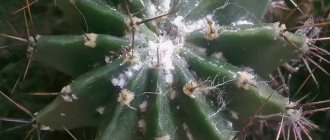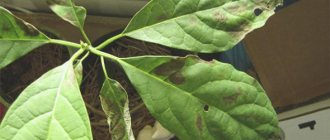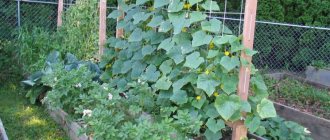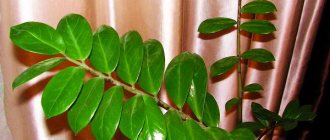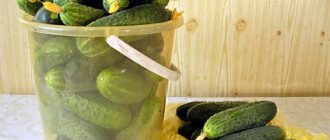Author rating
The author of the article
Yakov Pavlovich
Professor, Head of the Department of Vegetable Growing
Articles written
153
Why did white spots appear on the leaves of cucumbers? There can be many reasons - these are diseases (fungal or viral), and the negative impact of weather conditions. Experienced gardeners say: the appearance of spots is not always a reason to put an end to the crop - it is enough to change the irrigation regime, fertilization, and also to process cucumber bushes in a timely manner as a preventive measure.
Anthracnose
If the requirements for plant care are violated and the growing conditions deteriorate, a fungal infection - anthracnose may develop. The disease is characterized by the appearance of yellow spots on the leaf plates and the stem, which gradually turn brown.
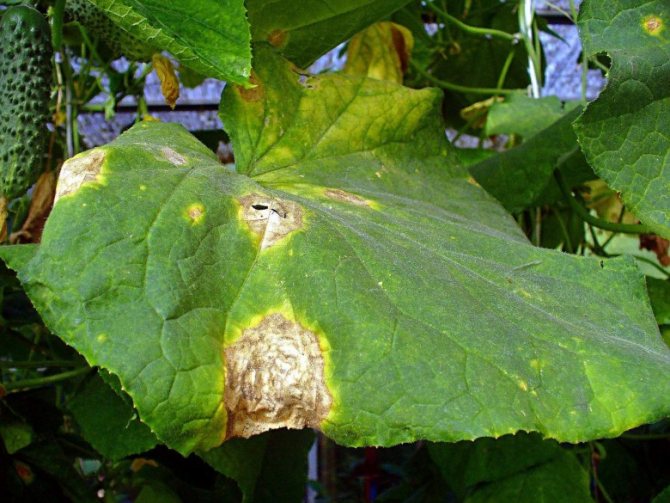
In the absence of timely treatment, such plaques degenerate into ulcers filled with pinkish mucus. In most cases, the disease affects greenhouse vegetables due to high humidity in the greenhouse. Outdoor plants rarely get sick with anthracnose.
Methods for treating yellow spots
Cucumber plantings in greenhouses are more susceptible to various diseases. This is due to the need to grow them in one place for several years in a row. When disinfectants are violated, diseases and pests constantly appear in the shelter.
To cope with the problems that have arisen, you should first revise the rules of care, apply fertilizers. But if the yellowness is not caused by violations of the rules of agricultural technology, then they resort to chemicals or folk recipes.
Chemical and bactericidal agents
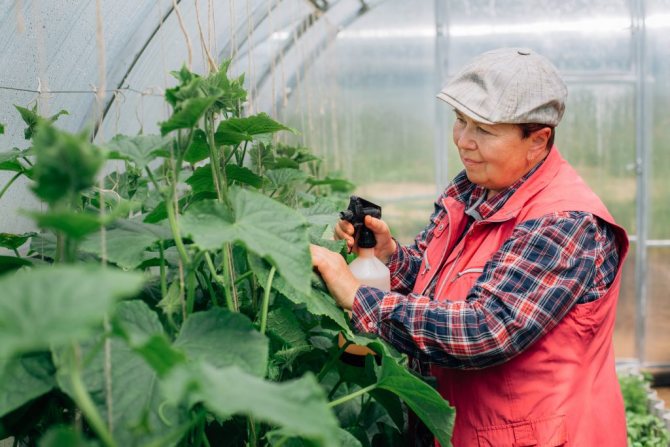

In specialized stores, there is a large selection of drugs that help solve problems. For the treatment of cucumbers, you can use various chemical or bactericidal agents.
- Fitosporin. A biologically active drug that is used from the beginning of the season for prevention purposes. Cucumbers are sprayed with a break of 2 weeks.
- Bordeaux liquid. An effective remedy for many diseases.
- Aktara is a complex preparation that helps to destroy pests.
- Maxim is the most effective remedy against late blight.
- Glyocladin. The solution is used to combat fungal spores.
On a note! Bordeaux liquid is used in the most difficult and advanced cases. Processing is carried out no more than 2 times per season.
Folk recipes
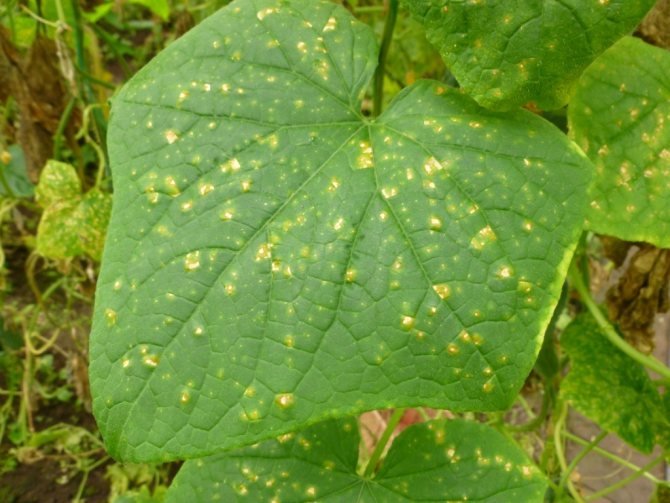

If there is no desire to use chemicals, then you can fight with folk remedies. They have been proven for years and help get rid of problems without chemicals.
- To restore cucumbers, use a milkshake. In a bucket of water, 1 liter of milk, 30 drops of iodine and 20 g of crushed laundry soap are diluted. It is necessary to process until the effect is obtained at intervals of 10 days.
- The easiest and most budgetary way is to spray the plantings with a weak solution of potassium permanganate.
- At the first appearance of yellow spots, they are treated with garlic tincture. A few cloves of garlic are chopped and poured into 1 liter of warm water. Insist for a day, then filter. A little laundry soap is dissolved in the resulting composition and the cucumber foliage is treated. Planting is sprayed several times.
- An effective remedy for restoring cucumber lashes is a solution based on bread and iodine.A loaf of bread is ground and stirred in a bucket of water. Day the composition is insisted. Add 1 jar of iodine. For spraying, dilute the concentrate with water in a ratio of 1:10.
- Onion peels can be used to control pests. It is boiled, insisted and chilled to room temperature. You can spray the plants, or you can pour 1 liter of the composition under each bush.
These simple recipes are effective. But if they do not help, do not waste time, they buy chemical preparations.
Ascochitosis
Another reason for the appearance of white spots on cucumbers is ascochitis. The causative agent of this disease is also a fungus that initially infects the lower leaves of the plant. Gradually, the infection rises up the stem, infecting not only the shoots, but also the fruit, which withers, turns yellow and then turns black.
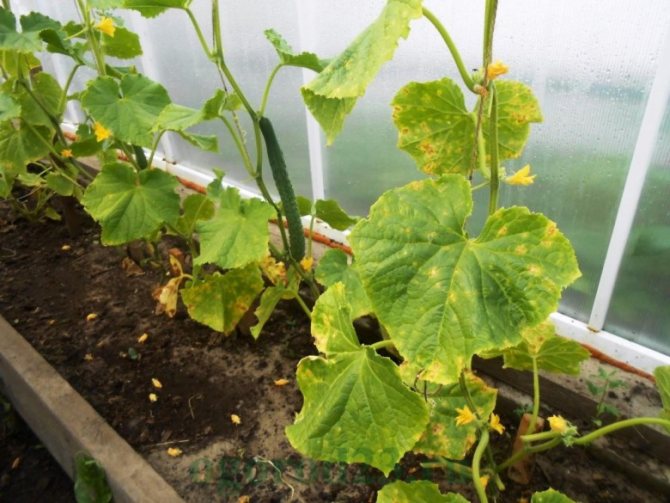

A distinctive feature of ascochitosis is the localization of spots not on the entire surface of the leaf, but on the edges of the leaf plate. White spots turn yellow, gradually acquiring a gray or brownish tint.


The final stage in the development of the disease is the appearance of black dots containing spores of the pathogen.
Growing cucumbers in a greenhouse
Planting cucumbers in the greenhouse is done when the ground under glass or film is well warmed up. Growing cucumbers in a greenhouse is a rather troublesome process. You need to carefully monitor the temperature, because the cucumber does not like sharp daily temperature drops. It is imperative to maintain the humidity inside the greenhouse using the irrigation method. Better to do it with rainwater.
If the weather is sunny and hot, it is necessary to ventilate the greenhouse. The cucumber does not like drafts, therefore, it must be ventilated carefully. It is very important to allow the bees to pollinate the flowers. Folk remedies for processing cucumbers will help here. Bees are reluctant to fly into enclosed spaces, and this can significantly reduce the yield. In order to attract the attention of insects, cucumber leaves in a greenhouse are sprinkled with sweet syrup. Between the rows of cucumbers, you need to put fertilizer, which cucumbers really need, especially at an early stage of development. Watering should be done not at the root, but along specially made hollows near the roots. In this case, you need to water only with warm water, and this should be done in the middle of the day. It is best to use drip irrigation in a greenhouse.
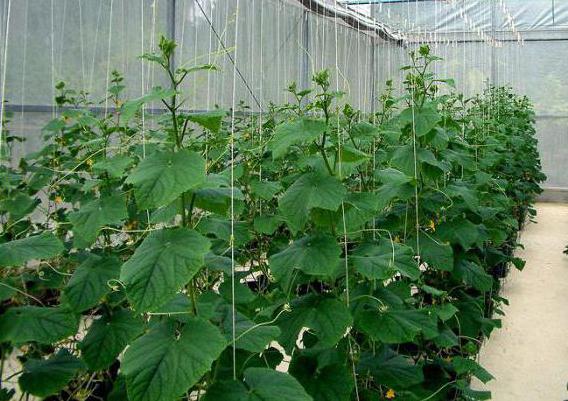

Downy mildew
Another fungal infection that affects plants is downy mildew or downy mildew. This disease is somewhat different from other symptoms.
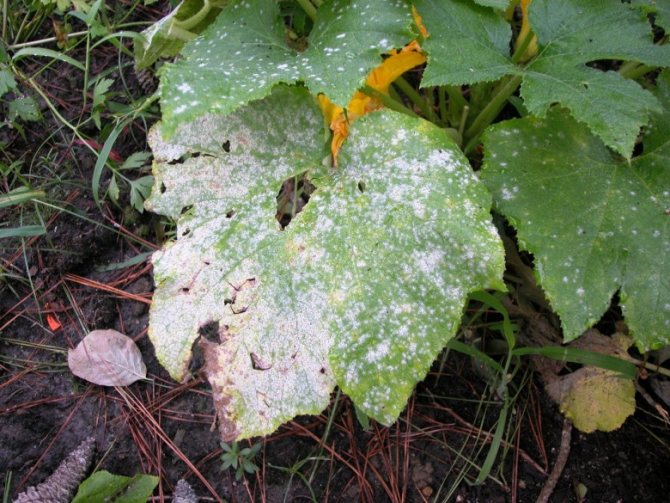

On a diseased plant, the first yellow spots appear on the upper side of the leaf plate in the area of the veins. At the same time, a gray or lilac bloom is formed on the lower part of the sheet plate, carrying spores.
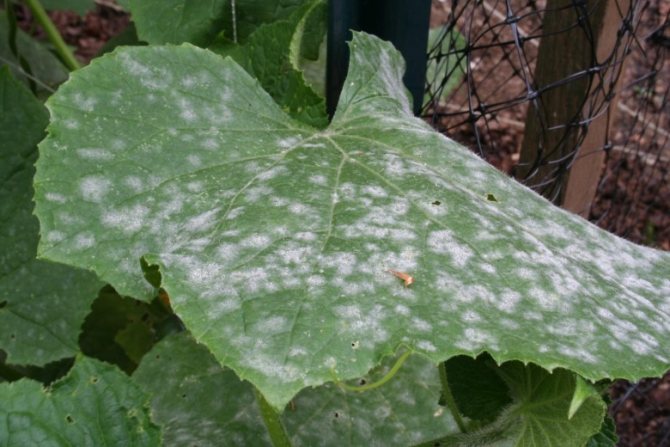

As the disease progresses, the yellow plaques turn brown and the affected tissues take on an oily texture. Gradually, leaves fall off, the plant gets sick and dies.
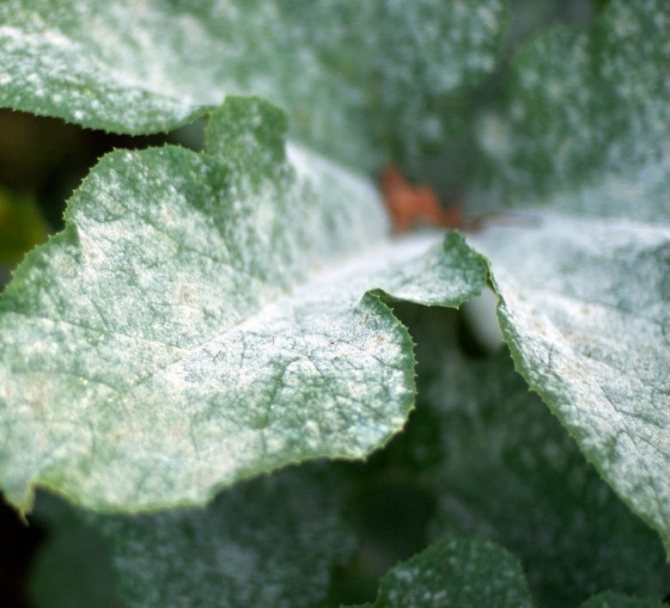

Why do cucumber leaves become covered with yellow spots and what to do at the same time
The variety of reasons leading to yellowing of cucumber leaves makes it difficult to take urgent measures to eliminate the problem.
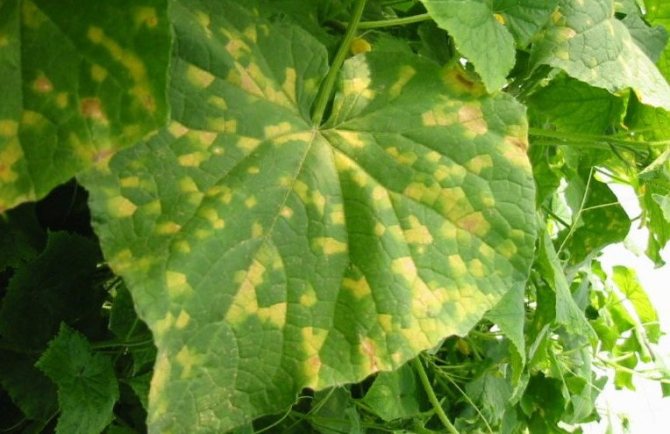

That is why it is so important to quickly identify the true cause of the disease, to understand what its symptoms mean in order to clearly define:
- from what and how to treat the plant;
- how to deal with pests;
- how the bushes should be treated;
- what to spray on the leaf surface;
- is it possible to do with folk remedies;
- how cucumber leaves react to processing and how their treatment ultimately proceeds.
Did you know? Greenhouses for growing cucumbers all year round were invented in ancient Rome.
Micronutrient deficiencies
If the soil is poor in nutrients, this usually affects the appearance of the leaf surface of cucumber bushes.
Moreover, the deficiency of a particular substance manifests itself in different ways:
- blotches on the leaves of a brownish hue, a yellow border around the edges and a pointed shape of the fruit indicates a lack of potassium in the soil;
- magnesium deficiency leads to yellowing of deciduous edges;
- if the veins on the leaf acquire a dark shade, and the rest of the leaf area turns yellow, this indicates that the soil is poor in iron;
- when only the upper part of the bush turns yellow, one can state a lack of copper.
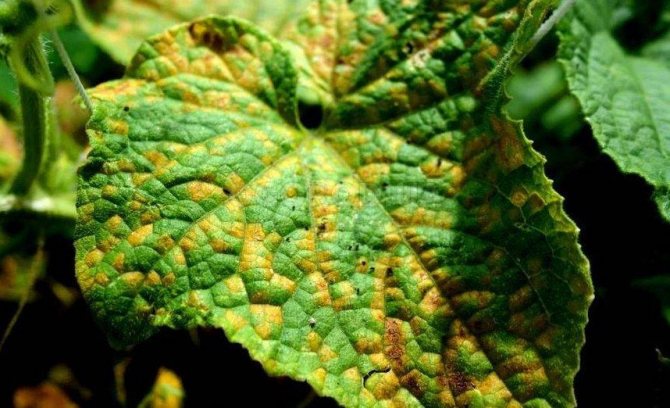

Lack of light
Being a light-loving culture, the cucumber still requires a certain balance in terms of illumination. Excessively bright light at the level of direct sunlight can lead to elementary burns to the leaf surface, as a result of which yellow-brown spots appear on it. However, inadequate lighting also adversely affects the cucumber plant, which ultimately leads to yellowing problems on the under-illuminated lower leaves.
In a greenhouse, along with lighting, temperature is also of great importance. If at optimal + 23 ... + 26 ° C the temperature there rises above + 28 ° C, then the cucumber leaves very quickly begin to turn yellow and then dry out.
Important! Not only a deficiency of nutrients in the soil, but also their excess can lead to yellowing of cucumber foliage.
Improper watering
Cucumber plantings require balanced watering. These plants are moisture-loving, but excessive watering creates considerable problems for them, leading, among other things, to yellowing of the leaves. But even with a lack of moisture in the soil, the roots begin to look for it on the surface of the soil and dry, as a result of which the leaves begin to become covered with yellow spots and then turn yellow completely.
Fungal diseases
In addition to obvious violations of agrotechnical rules for the cultivation of cucumbers, diseases caused by pathogenic fungi lead to the formation of yellow spots on the leaves.
Dry spot
Alternaria blight of cucumber, which is also called dry spotting, not only forms 2-centimeter yellow-brown spots on the leaf surface, but also dramatically reduces the yield of cucumbers in greenhouses within a month and a half. High humidity and temperature contribute to the development of this fungal disease. Fungal spores usually persist on seeds and plant debris. They fight this fungal disease by spraying with Oxychloride, as well as Bordeaux mixture every 2 weeks.
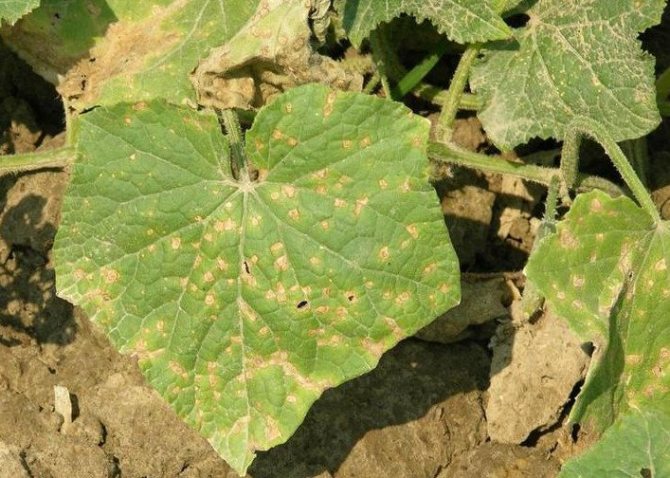

Pitioz
This disease in the form of root and root rot affects the root system of the cucumber, as a result of which the whole plant is inhibited.
Did you know? If you wipe the bathroom mirror with a piece of cucumber, it will not fog up, and rubbing the shoes with a cucumber slice makes them shiny and waterproof.
The appearance of this disease is facilitated by:
- increased soil and air humidity;
- too low temperature;
- excessively high temperature.
To prevent pityiasis, a month before sowing seeds, they are treated with the drug "Tiram" at the rate of 7 g of the drug per 1 kg of seeds.
To keep the plants from getting sick, it is helpful to strengthen their immune system in the cucumber plant with:
- "Amulet";
- "Immunocytophyte";
- "Narcissa";
- "The sprout".
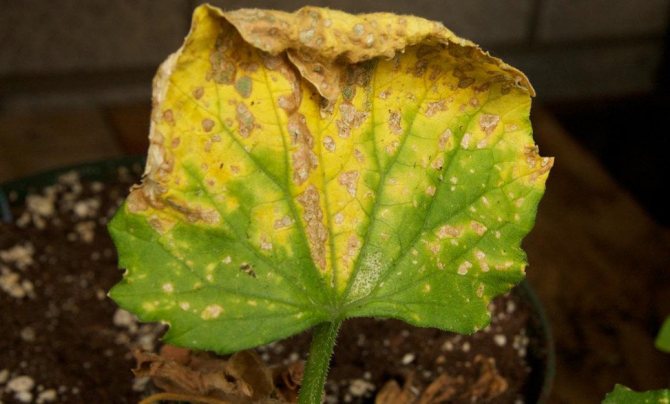

Fusarium
The appearance of infectious pathogens of this disease is provoked by high humidity in the air and soil. If signs of this disease appear, which manifest themselves in rotting of the stem at the root collar, yellowing and wilting of foliage, there is no need to talk about whether it is possible to save the crop, since no fungicides are able to cope with the fungus either in greenhouses or in open ground. Only preventive measures are possible, which consist in treating the soil before sowing seeds or planting seedlings with biofungicides in the form, for example, "Fitosporin-M" or "Trichodermina".
Video: fusarium cucumber or what to do if the leaves on a cucumber wither
Pests
In addition to fungal diseases, cucumber plantings are also attacked by pests that suck out the intercellular fluid from the leaves and, depriving them of life-giving juices, lead to the appearance of spots on them, and then to wilting.
Also find out why white spots appear on cucumber leaves and how to get rid of them.
Spider mite
This parasite, settling on the lower part of the leaves, sucks out nutrients from them, as a result of which numerous spots form on the leaf surface. In addition, the tick is a carrier of viral infections and fungal diseases.
This pest is very prolific and hardly amenable to complete destruction, so it is easier to prevent it on cucumber plants with the help of an infusion of garlic and onion peels, which successfully repels the parasite. And the destruction of ticks that have already appeared on cucumbers is greatly facilitated by a ladybug, to attract which it is useful to plant more dill near the cucumber beds.
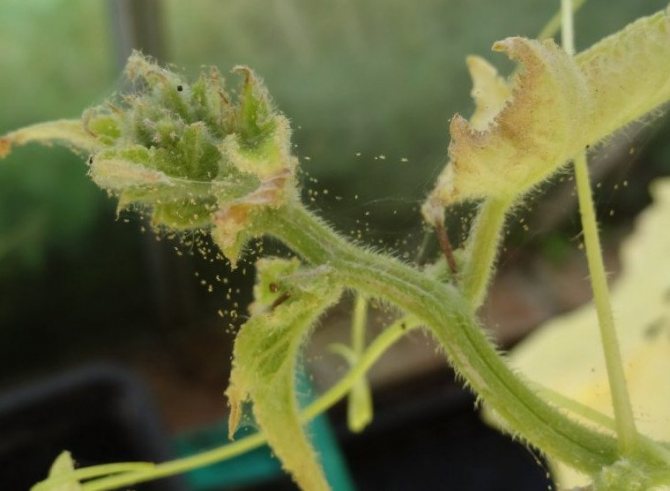

According to experts, insecticides practically do not affect the spider mite, therefore, for the prevention and control of it, it is more advisable to use acaricides or insectoacaricides, for example:
- "Appolo";
- "Plant-pin";
- "Anti-tick";
- Actellik;
- "Etisso";
- Fitoverm;
- Aktofit.
Whitefly
This parasite sucks nutritious juices from cucumber leaves. Insect leaf punctures look like multiple points, around which leaf tissue necrosis soon occurs. Dry yellow and brown spots form on the surface of the leaves, which over time absorb the entire leaf surface. The presence of whitefly on a cucumber bush is aggravated by the fact that a sooty fungus multiplies on the sweetish secretions left by the parasites, which makes its significant contribution to the destruction of the plant.
Learn more about how to deal with whitefly on cucumbers.
To combat whiteflies, various means are used, presented:
- simple mechanical destruction of the parasite;
- various traps;
- insect repellents;
- attracting the natural enemies of the whitefly in the form of ladybirds and lacewings;
- insecticides provided by Aktara, Warrant, Biotlin.
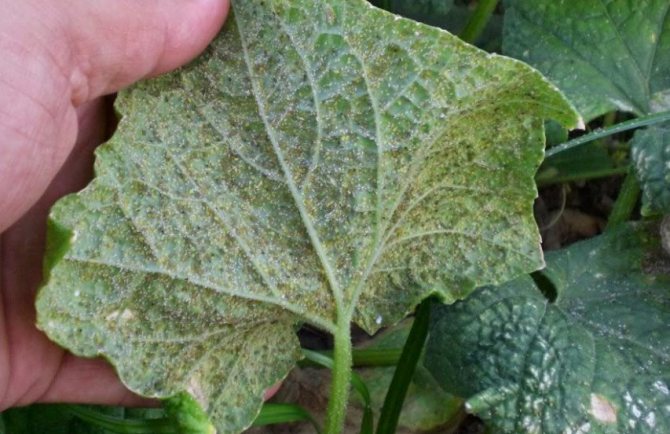

Mosaic
One of the viral ailments characteristic of cucumbers is mosaic. Young plants and seedlings are most affected. Small leaves turn yellow, and on larger leaves of cucumbers, white or yellow circular and star-shaped specks are formed.
Greenhouse sizes
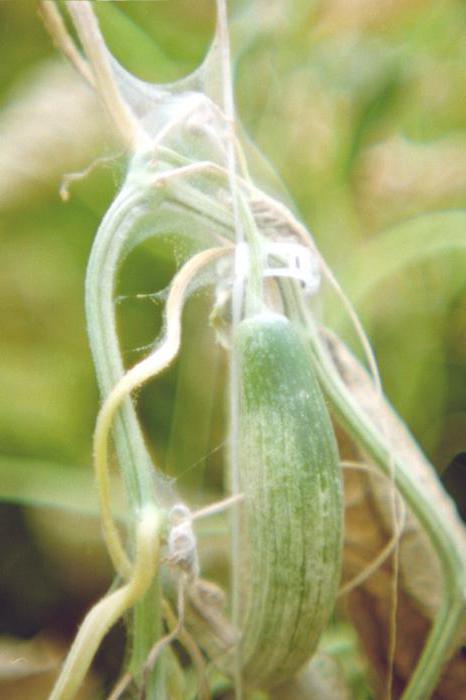

As for the size, the ideal dimensions for a greenhouse are three and a half by two and a half meters. Of course, the dimensions may be different, but it is not recommended to make it more than six meters in length. In such a greenhouse, the care and processing of cucumbers will be more difficult. It is better to divide it into several sectors. Doors should be wide enough to pass through with inventory and ventilate if necessary. If you follow all the recommendations, you will not have to then watch how white spots appeared on the leaves of the cucumbers or the branches dried up, and the leaves twisted.
Blackleg
Another disease caused by a fungus. A very insidious disease that affects seedlings. It spreads so quickly that it can destroy all juveniles in a short time.
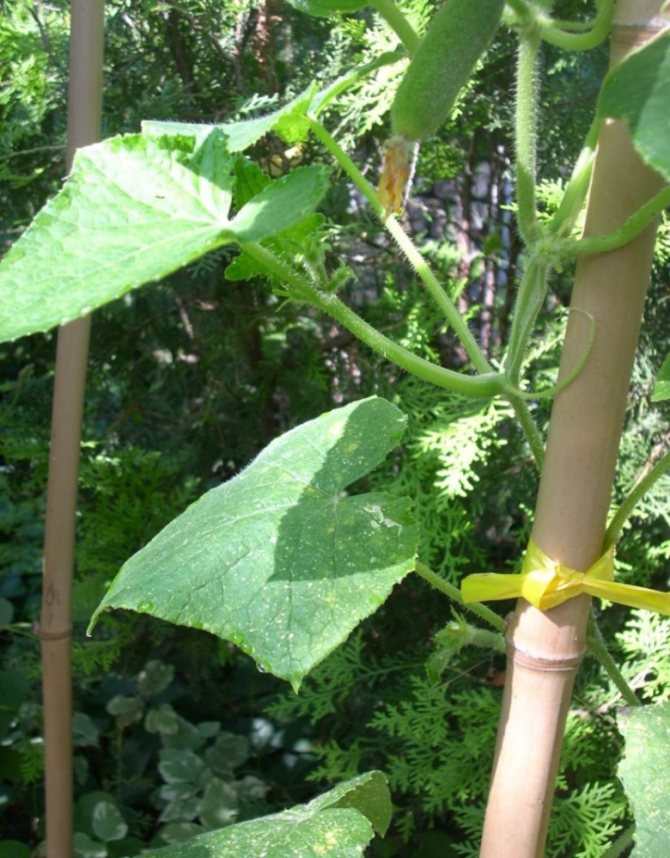

It is very simple to detect the disease - the lower leaves turn yellow, and the stem near the soil becomes soft, wrinkles and turns black. Together with the stem, the root system is affected.
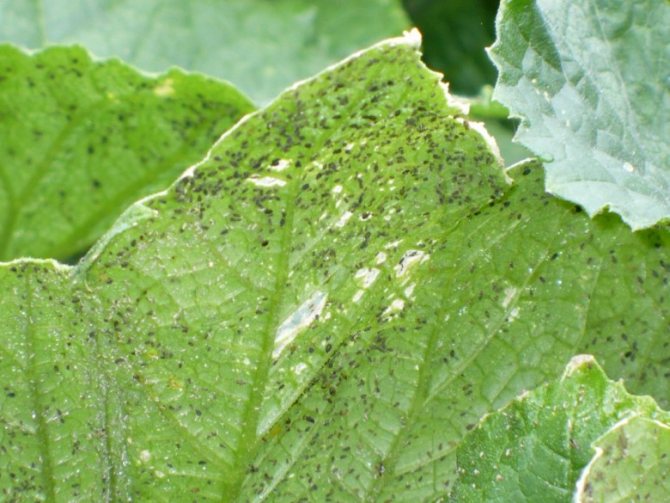

Cucumbers: open ground (care)


The main condition for proper care of cucumbers is regular watering. It is best to irrigate with drip irrigation. This allows moisture to flow directly to the root, reduces the amount of water and does not provoke weed growth.Watering cucumbers is necessary with water at room temperature or warm, so running water will not work. It is recommended to prepare a container for this purpose, in which the water will stand all day and warm up.
Watering is necessary depending on the condition of the soil. Watering too often can damage the crop, cucumbers will start to develop stems and weave instead of bearing fruit, or they may develop white spots on the leaves. In very hot weather, watering is needed more often, otherwise the leaves will wither. You can freshen the leaves a little with a shower of cool water. It will wash away dust, increase humidity and improve photosynthesis. If the leaves are still sluggish, you should pierce the ground with a pitchfork so that the water can penetrate to the root system.
Can be watered in three passes, one watering can at a time per hole; wait until the water is absorbed into the ground, and water again and again. Also, in addition to watering, it is important to regularly weed the beds from weeds. They prevent the plant from fully developing and create unnecessary shading.
Micronutrient deficiency
In addition to all kinds of viral, bacterial and fungal infections, cucumbers can suffer from a lack of trace elements in the soil. For example, when there is a lack of potassium, brownish spots appear on the leaves, and the edges of the leaf plate turn brown and curl.
With a lack of magnesium, yellowing of the leaves is observed in the area of the veins, and over time, the veins themselves turn yellow. These are not all the symptoms accompanying mineral deficiency, however, in both cases, the situation can be corrected by introducing the necessary mineral components into the soil.
Prevention measures
Diseases of cucumbers are easier to prevent than to deal with their consequences. Prevention begins with proper soil and greenhouse preparation... To do this, in the fall, all plants are removed by the roots and burned. The earth is dug up, the holes are watered with a solution of potassium permanganate. The greenhouse is ventilated for 2-3 days.
It is recommended to treat the seeds before sowing.... To do this, they are soaked in a solution of copper sulfate or potassium permanganate. Young shoots should be protected from temperature extremes and watered properly. Weeding should be done regularly, as many pests are spread through weeds.
Compliance with crop rotation - an important method for the prevention of diseases of cucumbers. The land on which the cucumbers grew last season is not suitable for replanting, so this area should be used for cucumbers after 3-4 years.
To prevent viral diseases it is recommended to water the plant with a solution of copper sulfate mixed with ash. The presence of ash in the soil will protect the plant from many other pathogens.

